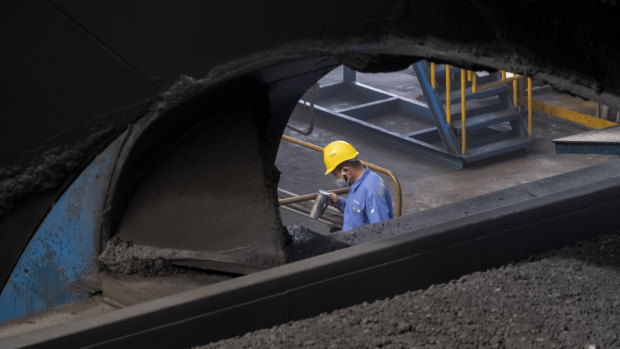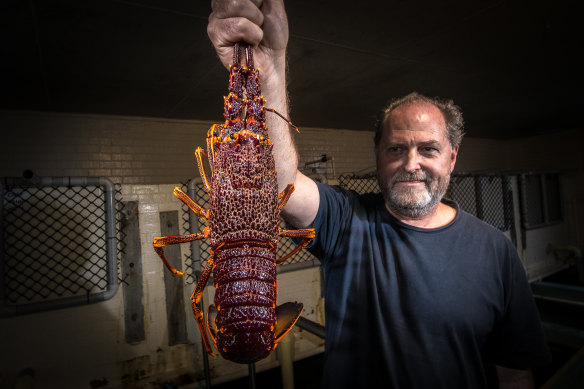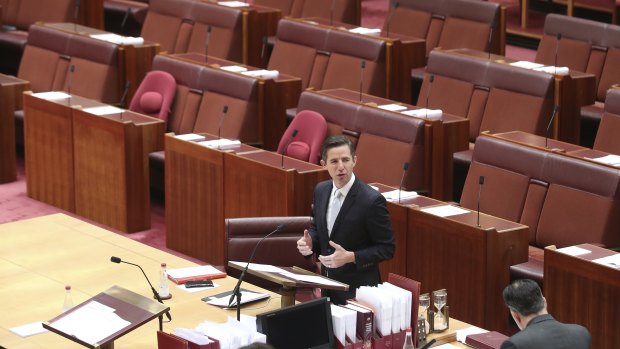This was published 4 years ago
How other nations are feasting on China's beef with Australia
By Eryk Bagshaw
At the China International Import expo in Shanghai last month, the Argentinian Beef Association was ready to pounce on Australia's misfortune.
Argentina has maintained strong diplomatic relations with China since the beginning of the coronavirus pandemic. Beijing sent tonnes of medical equipment to Argentina as COVID-19 began sweeping through Latin America. Even though they all had to endure 14-day quarantine to attend, 58 representatives of the beef association were in the hall to show off its sirloin and rib eye.

A worker monitors the coal dumping process at the Caofeidian Port in Hebei Province. Credit: Sanghee Liu
Australia is not unique. At least 60 countries count China as their number one export market.
Argentina is one of the hungriest, but also lining up: Russia, Indonesia, South Korea and Brazil. And all of them want a cut of Australia's lunch.
After years of galloping trade balances buttressed by iron ore and supported by farmers, fishers and loggers, Australia now faces a reckoning.
Its trade with China has been hammered by a year of diplomatic disputes characterised by economic threats from Beijing aimed at making Australia change course on national security, foreign affairs and human rights policies.
As Australia is forced to find new customers, others are ready to fill the void in the world's largest market.
Australian beef was first to be hit. Back on May 5, less than three weeks after Australia called for an independent inquiry into the coronavirus, China restricted imports from four of Australia's largest abattoirs citing vague labelling infringements. By December, another two would follow, severely limiting the $1.7 billion a year export trade.
The head of Argentina's meat export consortium, Mario Ravettino, said in October that COVID-19 had minimal impact on China’s demand for Argentinian beef.
“Our goal at the beginning of the year was to try to equal the 870,000 tonnes of 2019, and I think that at this time of the year we will reach that number,” he said.
In September, Australian beef exports to China were down 64 per cent compared to the same time last year, according to figures from the Department of Agriculture.
Barley was next. The grain used to make China’s Tsingtao beer was stung with an 80.5 per cent anti-dumping tariff on May 19. It was the same day that a motion first suggested by Australia to establish an independent review of the coronavirus passed the World Health Assembly.
China’s General Administration of Customs had been working on a proposal to allow Russian barley into the country following the fallout from the US-China trade war in 2019, which would also take in wheat and soybean imports.
Russia was approved in August. It now plans to ramp up its agricultural exports to China ten-fold, from a pre-deal low of $960 million a year to $9.6 billion.
Australian barley exports to China fell by 99 per cent in June. Within two months, Australia's wine producers were notified they were the subject of an anti-dumping investigation.
Australian wine is highly valued in China, coming second only to drops from France in terms of popularity if not sales. Treasury Wine's signature label, Penfolds, has the sixth highest name recognition in China, according to Hong Kong market research firm CLSA, which surveyed residents of 244 cities in September.
It found Australian products were still rated for their quality, value and natural attributes despite the ongoing diplomatic dispute.
But that popularity among punters matters little when the Chinese government can effectively shut a product out of the country and hobble a $1.2 billion export industry.
Tariffs of up to 212 per cent were applied to Australian wine exports to China in November on the basis of claims that Australian wines had been dumped into China at discount prices, squeezing out domestic producers.
The Australian government and local winemakers have described the claims as spurious and unjustified. France and Argentina are snapping at Australia’s heels. A third of the market has suddenly become available.
In the year to the end of May, 37 per cent of all foreign wine imported into mainland China was Australian, ahead of France on 27 per cent.
Argentina has paired its beef with a wine surge, adding more than 8 per cent year-on-year to November, despite the restrictions on freight and cargo created by the pandemic.
In October, Chinese power stations and steel mills were verbally instructed to stop importing Australian coal. Dozens of ships, hundreds of sailors and more than $700 million worth of coal are now stranded in Bohai Bay, prevented from unloading their cargo.
Coal is Australia’s third largest export to China, worth more than $14 billion last year.
China’s local coal mines are now Australia’s biggest competitor as Chinese state backed firms ramp up production and the government protects the local industry by imposing import quotas despite Australian coal being cheaper.
But other countries are also looking for a share of the market. Canada, Indonesia and Mongolia are among those leading the charge.
Glencore chief executive Ivan Glasenberg was frank about Australia’s prospects with reporters last week.
“We’re not selling from Australia at the moment, as you well know, they’re not discharging Australian coal, but we are selling from other destinations,” he said.
“China will still import about 185 million tonnes of thermal coal this year, which is similar to last year. So what Australia is losing is coming from other sources of supply.”
Copper is also a big seller. More than $2 billion a year is sent to China. It too was on a list of threatened exports flagged by a Chinese customs clearance agent in November along with timber, wine, barley, coal, sugar, and lobster.
Chile and Peru are the largest exporters of copper to China and S&P has warned Australia’s share can easily be replaced.
Chen Weixuan, a copper analyst with industry data provider Shanghai Metals Market told the global ratings agency that any restrictions will have limited impact on the Chinese copper industry given Australia's shares in China's imports.
"It's not difficult for Chinese buyers to seek alternatives in other countries ... they can also buy it from other large exporters or Asian traders in South Korea and Japan," he said
More than any other trade strike, the 20 tonne of Australian lobster dying on the tarmac at a Shanghai airport in November became an emblematic image for Australia's deteriorating relationship with Beijing.

Victorian Rock Lobster Association president Markus Nolle confronting the surplus. Credit: Justin McManus
Australia exports 94 per cent of its lobster catch to China, making it largely unviable for fishermen in Victoria and WA to keep fishing. Many have left the water.
North America and Indonesia are Australia’s largest competitors in the insatiable Chinese lobster market, which soared by 51 per cent between January and May according to Supermarket chain Metro China.
But their exports are also vulnerable to claims of diplomatic and economic coercion. Canada found that out in June when its lobster were also subject to enhanced screening measures for the coronavirus. The screening stopped some of its exporters' access to the market as diplomatic tensions rose between Ottawa and Beijing over the treatment of two Canadians detained in China, Michael Spavor and Michael Kovrig, on unspecified national security charges.
Perversely, despite the multiple trade strikes on more than half a dozen industries this year, Australia’s trade balance with China is actually expected to rise because of one $80 billion a year factor - iron ore. The resource, which is used to make steel, is critical for China's infrastructure boom.
Brazil, for all of its efforts to compete with Australia on iron ore shipments, has been unable to match the world’s largest supplier because of COVID-19 and two major mining flood disasters that have hampered its largest exporter Vale.
Due to supply constraints, the value of iron ore has risen by more than 55 per cent to $US142 a tonne this year. That surge has been very good for the Australian federal budget adding $2.5 billion in tax revenue for every $US10 increase.

Trade Minister Simon Birmingham. Credit: Alex Ellinghausen
But the extra tax revenue is cold comfort for the hundreds of smaller businesses and large exporters who are now being told by the federal government that they have to diversify their markets.
In his last appearance in the Senate as Trade Minister before a cabinet reshuffle next week, Simon Birmingham said that Australia would be staying the course as the government attempts to help businesses transition. He noted on Wednesday that Australia was not unique, but was one of dozens of countries who had helped accelerate China’s rise through trade. It now had no intention of trading away its values.
“We make no secret this competition is creating new dilemmas for us and for the rest of the global community,” he said. “Australia has been consistent about our principles and protecting our national interest.”
As Birmingham was speaking, Australia’s ambassador to China, Graham Fletcher, was preparing to meet with one of the Morrison government’s loudest and fiercest critics, Hu Xijin, the editor-in-chief of China’s international state media outlet, The Global Times.
The nationalist paper has been a key force driving the campaign for tougher action from Beijing on a recalcitrant Australia.
Over lunch, the pair agreed on little. Hu finished his account with a warning, if Australia does not change its stance: “China-Australia relations will hardly pick up, and Australia will continue to pay for its unreasonable China policy”.